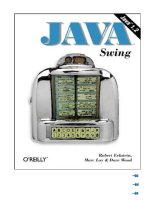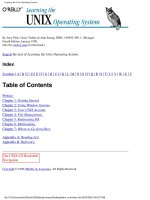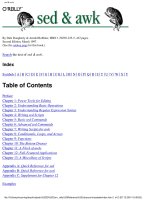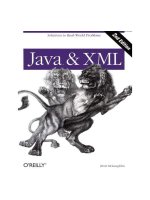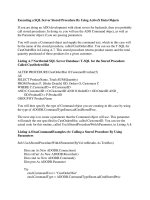o'reilly - ado activex data objects
Bạn đang xem bản rút gọn của tài liệu. Xem và tải ngay bản đầy đủ của tài liệu tại đây (2.35 MB, 627 trang )
IT-SC book
ADO: ActiveX Data Objects
Jason T. Roff
Publisher: O'Reilly
First Edition June 2001
ISBN: 1-56592-415-0, 618 pages
This book is a one-stop guide to ADO, the universal data
access solution from Microsoft that allows easy access to data
from multiple formats and platforms. It includes chapters on
the Connection, Recordset, Field, and Command objects and
the Properties collection; ADO architecture, data shaping, and
the ADO Event Model; brief introductions to RDS, ADO.NET,
and SQL; and a comprehensive alphabetic reference to every
ADO object, method, property, and event.
IT-SC book 2
IT-SC book 3
Copyright © 2001 O'Reilly & Associates, Inc. All rights reserved.
Printed in the United States of America.
Published by O'Reilly & Associates, Inc., 101 Morris Street, Sebastopol, CA 95472.
Nutshell Handbook, the Nutshell Handbook logo, and the O'Reilly logo are registered trademarks
of O'Reilly & Associates, Inc. Many of the designations used by manufacturers and sellers to
distinguish their products are claimed as trademarks. Where those designations appear in this
book, and O'Reilly & Associates, Inc. was aware of a trademark claim, the designations have
been printed in caps or initial caps. The association between the image of an ivory-billed
woodpecker and ActiveX Data Objects is a trademark of O'Reilly & Associates, Inc.
While every precaution has been taken in the preparation of this book, the publisher assumes no
responsibility for errors or omissions, or for damages resulting from the use of the information
contained herein.
IT-SC book 4
Preface
Introduction and Organization
Conventions Used in This Book
Comments and Questions
Acknowledgments
I: Learning ADO
1. Introduction to ADO
1.1 ADO in Context: Universal Data Access
1.2 ADO and COM: Language Independence
1.3 When to Use ADO
1.4 Summary
2. The ADO Architecture
2.1 An Overview of the ADO Architecture
2.2 ADO Components
2.3 Summary
3. Accessing ADO with Various Languages
3.1 Accessing ADO with Visual Basic
3.2 Accessing ADO with Visual C++
3.3 Accessing ADO with Visual J++
3.4 Accessing ADO with VBScript
3.5 Accessing ADO with JScript
3.6 Summary
4. The Connection Object
4.1 Opening and Closing a Connection: Implicit Versus Explicit
4.2 Configuring Connections
4.3 Choosing a Data Provider
4.4 Executing Commands
4.5 Managing Multiple Transactions
4.6 Determining the Layout of Your Data Source
4.7 Summary
5. The Recordset Object
5.1 Cursors: Viewing a Recordset
5.2 Working with Recordsets
5.3 Navigating a Recordset
5.4 Working with Records
5.5 Lock Types: Managing Access to a Recordset
5.6 Summary
6. Fields
6.1 The Fields Collection Object
6.2 Field Specifics
6.3 Determining Field Object Functionality
6.4 Summary
7. The Command Object
7.1 Specifying Commands
IT-SC book 5
7.2 Executing Commands
7.3 Parameters
7.4 The Parameters Project
7.5 Asynchronous Execution
7.6 Summary
8. The ADO Event Model
8.1 Introduction to Events
8.2 The ConnectionEvent Family
8.3 The RecordsetEvent Family
8.4 Canceling Operations
8.5 Turning Events Off
8.6 Summary
9. Data Shaping
9.1 An Introduction to Data Shaping
9.2 The Microsoft Data Shaping Service
9.3 Shaping Commands
9.4 Example: Accessing Shaped Recordsets
9.5 Summary
10. Records and Streams
10.1 The Record Object
10.2 The Stream Object
10.3 Summary
11. Remote Data Services
11.1 RDS Object Model
11.2 An Example in RDS
11.3 More Information About RDS
11.4 Summary
12. The Microsoft .NET Framework and ADO.NET
12.1 The Microsoft .NET Framework
12.2 ADO.NET
12.3 ADO.NET Features
12.4 Summary
II: Reference Section
13. ADO API Reference
13.1 Finding the Reference Page
13.2 Using the Reference Pages
III: Appendixes
A. Introduction to SQL
A.1 Record Selection
A.2 Data Manipulation
A.3 Database Modification
B. The Properties Collection
B.1 The Property Example
IT-SC book 6
C. ADO Errors
C.1 Working with Errors in ADO
C.2 The Errors Example
D. The ADO Data Control
D.1 The ADO Data Control Property Pages
D.2 Creating Connection Strings with the ADO Data Control
D.3 The ADO Data Control Example
E. Enumeration Tables
Colophon
IT-SC book 7
Preface
This book is about ActiveX Data Objects (ADO), including Version 2.6, the latest release of
ADO from Microsoft at the time of publication. In this Preface, I will first briefly introduce ADO
and explain how the book is organized.
Introduction and Organization
This book is organized into three parts, as described in the following sections.
Part I: Learning ADO
ADO is Microsoft's advanced universal data-access solution, consisting of an object model-based
wrapper around OLE DB, which is a technology that allows data-access functionality to different
types of data sources. This allows companies such as Oracle, Microsoft, and Sybase to develop
what are called "data providers," to do just that provide data to the OLE DB technology. OLE
DB technology can work with all kinds of data sources, including relational databases such as
SQL Server or an email system such as Exchange. OLE DB and ADO can even deal with plain
text files and Excel spreadsheets.
Chapter 1, and Chapter 2, provide more information on ADO,
related technologies, and the structure of key ADO components.
ADO adds a common programming interface to OLE DB, thus allowing developers to use
existing skills with multiple languages. ADO can be used with virtually any development
language that supports COM, such as Visual Basic, Visual C++, J++, JScript, and VBScript.
Developing with ADO in each of these languages is discussed in
Chapter 3. ADO was designed
to encourage DAO and RDO developers to migrate to this new technology, without the burden of
the many different objects of DAO and RDO.
ADO is a lightweight, disconnected object model, which means that it has few objects, as
compared to DAO or RDO, and that the objects do not necessarily rely on each other. For
instance, one of the most common objects of ADO is the Connection object (
Chapter 4). This
object establishes a physical connection with a data source. But you don't need it: the other
objects of ADO, such as the Command object, which issues textual commands to the data source,
and the Recordset object (
Chapter 5), which is used to store a result set, can create their
Connection objects internally if they need to. Of course they use some default options, and hence
the advantage of creating your own Connection more power and control over your data access.
The Fields Collection object represents, unsurprisingly, a collection of fields contained in every
Recordset object.
Chapter 6, explains the Fields Collection object, as well as the Field objects.
Another example of ADO disconnected object model is the Command object, covered in
Chapter 7. The Command object issues commands such as SQL statements. You can actually
issue statements through the Connection object if you don't mind using the default values. In this
case the Connection object creates its own Command object internally to get the job done.
Asynchronous operations are a very big selling feature with a data-access technology and ADO
definitely does not fall short in this category. With the ability to fire events when asynchronous
operations are executing and when they complete, ADO offers much greater control of your data
IT-SC book 8
access than did previous data-access technologies such as DAO. In addition to asynchronous
operations, events can be fired for transactions, connecting and disconnecting to a data source, as
well as moving around a recordset and changing values within it. Events are covered in
Chapter
8.
One of the unique features of ADO is its ability to use the Data Shaping data provider, which
allows you to write code that can store hierarchical data within a single Recordset object. It
allows you to shape result sets into parent-child relationships, where a single field value can
contain an entire child recordset. Data shaping is covered in
Chapter 9.
A newer functionality in ADO is the ability to connect to web resources with not only the
Recordset object, which stores result sets, but with the Record object, which stores individual
rows, and the Stream object, which represents the actual content of a resource, such as a file or a
directory.
Chapter 10, explains these topics.
Remote Data Services (RDS) extends ADO functionality to three-tier web applications.
Chapter
11, provides an overview of RDS.
Chapter 12, offers a glimpse into the next generation of ADO and related technologies, in the
form of ADO.NET and the .NET Framework and how they will interact with today's ADO
projects.
Part II: Reference Section
Part II consists of Chapter 13. For this chapter, I have compiled an exhaustive list of every
object, method, property, event, and enumeration in an easy-to-use alphabetical reference. See
also
Appendix E.
Part III: Appendixes
Appendix A, provides just that an introduction to using SQL with the Microsoft Jet Engine
SQL language, including record selection, data manipulation, and database modification.
In
Appendix B, I explain the Properties collection, which exists within and provides information
about ADO objects. ADO is a flexible framework that exposes the functionality of the data
provider. Nothing guarantees what functionality a data provider will actually provide your
application, but ADO does dictate the interface used for supported functionality. ADO has what it
calls "dynamic properties," which can be used to understand the functionality supported by the
data provider and to set data provider specific properties that aren't part of the ADO framework.
This flexibility that ADO offers contributes to its longevity.
Appendix C, lists trappable errors and data-provider errors, as well as methods for handling them.
Appendix D, explains the ADO Data Control Property Pages and how to create connection
strings with the Data Control property, including an example application.
The companion to the
Chapter 13 reference is Appendix E, which alphabetically lists
enumerations used by ADO objects and collections.
About the Book
IT-SC book 9
This book covers ActiveX Data Objects up to Version 2.6. It covers every class, method, property, and
enumeration included with this release. This book has three sections; the first is a tutorial that explains how
each of these components work, with examples in Visual Basic along the way. The second part of this book
is a practical reference guide that allows you to easily look up any component to see every piece of detailed
information available for it. The third part of this book contains several appendixes providing related
information, as well as reference tables.
Although this book includes small sections on Remote Data Objects (RDO), ADO.NET (from
Microsoft's .NET Framework), and SQL, it by no means attempts to cover these subjects to any degree of
completeness.
Audience
While this book is intended for any person interested in learning about ADO, it is targeted more
specifically to the experienced Visual Basic developer who understands the basic principles
behind data access and manipulation. This book provides many introductions to secondary topics,
including SQL (
Appendix A), RDS (Chapter 11), and others, in order to help the less-
experienced reader understand all facets of ADO in context.
This book assumes that you know how to develop in Visual Basic or you at least understand how to read
it. Knowledge of one of Microsoft's early database technologies (DAO or RDO) is helpful, but not
necessary.
Conventions Used in This Book
I use the following font conventions in this book:
Italic is used for:
New terms where they are defined
Internet addresses, such as domain names and URLs
Pathnames, filenames, and program names
Constant width is used for:
Code examples for Visual Basic, C++, Java, and other languages
Specific names and keywords in Visual Basic programs, including method names, property
names, variable names, enumeration names, constants, and class names
Constant width italic is occasionally used for placeholder items in code, replaceable by a
specific item in your code.
Comments and Questions
I have tested and verified the information in this book to the best of my ability, but you may find that
features have changed (or even that I have made mistakes!). Please let me know about any errors you find,
as well as your suggestions for future editions, by writing to:
O'Reilly & Associates, Inc.
IT-SC book 10
101 Morris Street
Sebastopol, CA 95472
(800) 998-9938 (in the United States or Canada)
(707) 829-0515 (international/local)
(707) 829-0104 (fax)
There is a web page for this book, which lists errata, any plans for future editions, or any additional
information. You can access this page at:
/>
To comment or ask technical questions about this book, send email to:
For more information about books, conferences, software, Resource Centers, and the O'Reilly Network, see
the O'Reilly web site at:
IT-SC book 11
Acknowledgments
The people I need to acknowledge the most are the good folk at O'Reilly & Associates, starting with Ron
Petrusha, who put up with me while still insisting on a quality piece of work. John Osborn and Nancy
Kotary brought it home. Thank you very much for your expertise, guidance, persistence, and understanding.
I need to thank the technical reviewers who while they didn't go easy on me didn't beat me up too bad,
either. This includes Bob Beauchemin and Ben Willet's MDAC team over at Microsoft: Steve Hoberecht,
Rick Feinauer, and Irene Smith. I'd also like to thank the O'Reilly Production staff. Specifically, thanks to
my Production Editors, Jeffrey Holcomb and Sarah Jane Shangraw, and the additional Production staff who
worked on this book: Linley Dolby, Matt Hutchinson, and Claire Cloutier.
And last but not least, my wife, who put up with me working on this book, before we were married, after
we were married, before she was pregnant, while she was pregnant, and after she gave birth to my son,
Zachary the real reason I finished this book. I love you both.
IT-SC book 12
Part I: Learning ADO
IT-SC book 13
Chapter 1. Introduction to ADO
In today's computing environments, data exists in many formats, ranging from Access
and SQL Server databases to Word documents, email messages, and many others. ADO,
or ActiveX Data Objects, data-access technology simplifies use of data from multiple
sources, thus freeing developers from learning data, vendor-specific API calls, and any
other coding minutiae for each data format involved. With ADO, almost any data source
becomes accessible in a consistent way for developers creating standalone applications,
client/server applications, or ASP pages.
In this chapter, I define ADO in the historic and current context of Microsoft's overall
data-access strategy and related technologies.
1.1 ADO in Context: Universal Data Access
Microsoft's philosophy behind ADO and a series of related technologies is Universal
Data Access ( UDA). UDA isn't a tangible product or technology, but rather a strategy for
attacking the problem of data access, whose goal is efficient and powerful data access,
regardless of data source or development language. Moreover, this universal access is
meant to eliminate the need to convert existing data from one proprietary format to
another.
With this lofty goal in view, Microsoft developed a series of technologies, collectively
known as Microsoft Data Access Components ( MDAC), that allow developers to
implement UDA. MDAC consists of the following four key pieces:
ODBC (Open Database Connectivity)
OLE DB (Object Linking and Embedding Databases)
ADO (ActiveX Data Objects)
RDS (Remote Data Service)
These components implement the UDA vision both individually and as a whole. To best
understand ADO in context, you should have a basic understanding of each MDAC
technology and its relationship to ADO.
1.1.1 ODBC
Open Database Connectivity, or ODBC, provides access to relational databases through a
standard API, addressing the problem of native application and platform-specific APIs
and their lack of cross-application compatibility. ODBC's industry-standard architecture
offers an interface to any Database Management System (DBMS), such as SQL Server or
Oracle, that uses the standard ODBC API. The main drawbacks of ODBC are the amount
of work required to develop with it and its restriction to SQL-based data sources.
IT-SC book 14
Two COM components (Component Object Model see "ADO and COM: Language
Independence" later in this chapter) designed to help with ODBC complications are DAO
and RDO, described briefly in later sections in this chapter.
1.1.1.1 Jet/DAO
With the release of Microsoft Access 1.1 in 1993, Microsoft introduced the Jet Database
Engine, which worked with Access databases (Microsoft Access Databases, or MDB
files), ODBC-supported data sources, and Indexed Sequential Access Method databases
(ISAM, which includes Excel, dBase, and a few other databases).
Data Access Objects (DAO) was introduced as a means of interacting with Jet. DAO,
through COM, provided an object-oriented interface to Jet and Microsoft Access.
Jet and DAO were successful in their flexibility but added layers to the ODBC API and
were therefore more efficient for some databases (Access/MDB and ISAM) than others,
including Relational Database Management Systems (RDBMS). DAO is still widely used
today, but it is most appropriate for single-user, low-traffic database applications. The
problem with DAO, as many soon began to see, was that it was so full-featured that it
brought with it a profusion of objects. Figure 1-1 shows the DAO object model.
Figure 1-1. The DAO object model
IT-SC book 15
As you will see later in this chapter and in other chapters, ADO was designed to address
this and other problems with DAO.
1.1.1.2 RDO
Microsoft's response to the developer's need for easier access to ODBC data sources
came, in 1995, in the form of Remote Data Objects, or RDO. RDO provided more direct,
and therefore faster, access to the ODBC API, as well as support for RDBMS sources.
With RDO, the emphasis moved from data-access methods designed for ISAM databases
toward techniques to provide for stored procedures and the results that they returned.
RDO lacked some of the power that DAO offered with Jet (for instance, RDO is not
designed to access ISAM sources and does not allow the creation of new databases), but
it offered more power for newer, more robust enterprise systems.
IT-SC book 16
The problem with RDO is that it is very different from the DAO architecture, which means two
things. First, developers had to learn a new interface, and second, converting an existing DAO
application to RDO involved a lot of additional development, because almost every piece of RDO
differed from DAO, as you can see by comparing
Figure 1-1 and Figure 1-2 (the RDO object
model). With the introduction of RDO, developers chose between DAO and RDO instead of
moving directly to RDO and abandoning DAO.
Figure 1-2. The RDO object model
1.1.1.3 ODBCDirect
ODBCDirect was provided as part of a later release of DAO; to save time, it allows
developers to work directly with Access sources without using Jet as the go-between. It is
similar to DAO's object model but includes RDO's direct access to remote data sources.
1.1.2 OLE DB
ODBC provides access only to relational databases. Its successor, Object Linking and
Embedding Databases (OLE DB), includes all other data sources. OLE DB is the
foundation upon which ADO relies.
OLE DB provides the following features:
Access to data regardless of its format or location (via COM see "ADO and COM: Language
Independence" later in this chapter)
IT-SC book 17
Full access to ODBC data sources and ODBC drivers
A specification that Microsoft wants to act as a standard throughout the industry
OLE DB comprises four types of components;
Figure 1-3 shows their relationships, which are
described here:
Data consumer
Any application or tool that accesses data from a data source. While the API calls that are
available to access the data in your database are considered data providers, the application that
uses that data itself is a data consumer, since it requests the data from the data provider.
Data service provider
The engine that makes OLE DB work; the resource necessary for a data provider to be able to
provide data. A data service provider is a modular or add-on component that allows an
application to deliver data through OLE DB. Data service providers are usually provided by the
vendor for major products such as Oracle, DB2, and Informix. Microsoft promotes the creation of
data service providers by either the manufacturer of the data provider or a third-party company.
Business component
A go-between for a data provider and a data consumer. In today's development environment, it is
becoming more and more important not to develop in such a way that every object in your
application manipulates your data. With a business component that you call to access your data,
which in turn calls your database access component (ADO, RDO, ODBC, OLE DB, or ADO),
then you need only modify the code in that business component.
Data provider
A component (application or database engine, for example) that delivers data from a data source
(such as a database, spreadsheet, or email message) in a consistent manner.
Figure 1-3. OLE DB component relationships
ODBC, as we have just seen, is an excellent technology for accessing SQL-based data.
OLE DB incorporates this proven technology with a particular component that allows
OLE DB consumers to communicate directly with ODBC providers. In other words, use
IT-SC book 18
OLE DB to access SQL-based data, and you gain the advantage of being able to access
both relational and other forms of data with the same code.
As they have done with ODBC, Microsoft is actively encouraging software vendors and
tool developers to support the OLE DB standard within their applications and tools.
Widespread standardization is an advantage for developers; with OLE DB, we can ensure
that our applications become more robust and more powerful as they span the enterprise.
Keep in mind that OLE DB was designed for software vendors who develop data-based
applications to expose that data to you, an end-user developer, through a consistent
interface. OLE DB is fast, efficient, and powerful. It has everything a developer looks for
in a data-access technology. It offers access to any data source known to man (or to
Windows, for that matter), and it provides access to these data sources with a consistent
interface, regardless of data source. The problem with OLE DB is that, like ODBC, it is
inaccessible to Visual Basic and other developers, because it is based on a C-style API.
Visual Basic developers, in particular, needed more.
1.1.3 ADO
Enter ActiveX Data Objects (ADO). ADO, an application-level interface to OLE DB, is
the latest, greatest piece of Microsoft's UDA strategy. It combines the best features of its
predecessors, DAO and RDO, and adds OLE DB accessibility for VBA programmers.
ADO provides a consistent, language-independent means to access data from almost any
source, including text-based or other legacy data in relational and nonrelational formats.
(You can now see why I needed to explain some of the alphabet soup before getting to
ADO itself.)
ADO comprises a collection of object libraries in a new, modular object model: in this
new model, many objects can exist independently of the others, as you will see in later
chapters of this book. The ADO object model is more flexible than the DAO object
model, but it's similar, so programmers familiar with DAO will feel at home with ADO.
ADO is a smaller version of DAO, generalized to allow easy access to any data source,
not just Jet databases or ODBC data sources. The ADO object model simplifies data
access more than DAO or RDO did by using fewer objects. See
Figure 1-1 and also
Chapter 2, for more information.
Used with OLE DB, ADO provides fast, simple access to almost any data source. It
allows developers to use a single, consistent interface to new and legacy databases and
other data sources of all formats, when creating desktop or web-based applications.
ADO can also use the OLE DB provider for ODBC. Instead of removing the already
proven and tested code for ODBC drivers, ADO allows you to use ODBC through the
same interface you would for OLE DB. This may be an option when you have code you
are migrating from RDO, which already uses ODBC.
ADO breaks the common characteristics of all data sources into easy-to-use components
(which we will look at in
Chapter 2). Consistency and language-independence are
IT-SC book 19
provided, so that developers can worry more about the content and quality of applications,
rather than about the techniques used in delivering data or the type of data being used.
What does language-independent development mean? It is quite simple one technology,
one development interface. You will use the same object, method, and property names
with ADO, regardless of the development language that you are using. The difference is
almost unnoticeable. Under the covers, ADO, through COM (Component Object Model),
worries about the particular language you are developing with, whether it is Visual Basic,
Visual C++, or Java. Even scripting languages, such as VBScript and JavaScript in
HTML pages are supported. We will look more closely into programming for these
different languages in Chapter 3.
With this feature, you might expect that a lot of specific functionality of data sources
would be lost. On the contrary, ADO allows the developer to access any data source-
specific commands, methods, properties, and utilities that the vendor has made available
through OLE DB. And yes, ADO does this in a well-structured, consistent way. Can you
possibly ask for more?
As we will see in chapters to come, an application can be designed to access a simple
database, such as Access, and with a little bit of additional code, it can later access more
intricate databases, such as SQL Server databases, Word documents, or email files. The
only real coding necessary involves altering the connection string used in ADO to read
the new data source. This powerful technology will help us move into the future as
applications begin to grow across enterprises.
1.1.4 RDS
The final piece of data-access technology in this list of the MDAC components is Remote
Data Services (RDS). RDS, based on existing Active Data Connector (ADC) technology
integrated into ADO, transports ADO objects via proxy between server and client, thus
allowing developers to create web-based applications that can access data on the server in
new ways. Some of the advantages of RDS are:
Client-side caching of data results
Ability to update data from the client
Support for data-aware ActiveX components and controls
Client-side caching is something that we will all grow to love. With it, clients (end-users)
are able to view data from the server without making numerous round trips. For instance,
when you are using a search engine on the Internet, such as Yahoo!, you receive a list of
links that relate to your search, usually in groups of tens. If you want to see the next ten
sites from the resulting search, your browser must make another request to the server.
With client-side caching, all of the data is sent to the client, so that the client can browse
this data without incurring time delays that are associated with additional requests. This
feature reduces local-area network and Internet traffic and allows the end-user to move
IT-SC book 20
freely through data without unnecessary pauses and to perform operations on that data,
such as sorting and filtering.
With RDS, web pages can now offer the client the ability to interact with and alter data.
This data can be sent back to the server after manipulation. At the server, the data can be
verified and then returned to the data source. With this technology, your client/server
applications can span the Internet (or your intranet). Clients can now invoke server-side
automation objects through HTML, meaning that particular business rules (chosen by the
developer) can be accessed via the client.
RDS enables three-tier client/server applications, with the model shown in Figure 1-4.
Figure 1-4. The three-tier client/server web-based application model
With automation objects, your application can become an auto-downloaded application.
For businesses with a large number of client-side users, you can create, maintain, and
update your application on the server alone. When clients run your application, they can
use an ActiveX-aware browser (Internet Explorer) to access the application. With auto-
download features built into the browser, the client receives an updated version of the
application.
RDS also supports data-aware ActiveX controls that can be placed within an HTML page
on a client. For instance, if you want to allow the client to view a list of documents that
you have stored in your data source on the server, you could link RDS to an ActiveX list
box control that is placed in the HTML page and downloaded to the client. The control
interacts automatically with RDS, without any additional programming, to download all
of the document names.
IT-SC book 21
See Chapter 11, for a more detailed introduction to RDS.
1.1.5 Putting It All Together
With the addition of RDS to its MDAC family of components, Microsoft has integrated
several useful existing technologies into the universal data-access strategy: IE data-access
technology for data-bound web pages, remote data capability through RDS, and ASP/IIS-
related technologies for better access to data services via the Internet. The result allows
applications to work with data offline to reduce network traffic, update data on remote
clients, and gather data asynchronously for faster response time.
Figure 1-5 shows the relationships and dependencies of the MDAC components.
Figure 1-5. MDAC architecture
As you can see from Figure 1-5, your application can use a number of different
Microsoft-supplied technologies to access SQL as well as non-SQL and legacy data,
such as that residing on a mainframe.
Until ADO, we had four choices: DAO, RDO, ODBC, and OLE DB. DAO served its
purpose well: it used the power of the underlying ( Jet) database engine to access
Microsoft and other ISAM data sources. With RDO, things were even better with its
easy-to-use interface to ODBC and ability to access almost any SQL data source.
Accessing ODBC directly was always a possibility, but it was questionable whether the
overwhelming amount of work was worth the extra speed gained in the process. Finally,
OLE DB offered everything under the sun. It offered access to ISAM, SQL, non-SQL,
IT-SC book 22
and legacy data. However wonderful OLE DB was, it is considered the most difficult
interface with which to develop to access data sources. This is where ADO comes into
play. ADO reports directly to OLE DB and no one else, meaning that it provides an
interface to the whole complicated mess, about which we need to know little or nothing.
ADO provides a consistent development interface to the wonders of OLE DB, and it does
so while being language-independent.
1.2 ADO and COM: Language Independence
Microsoft's Component Object Model, better known as COM, is a mature technology that
offers universal access to components, regardless of the language in which they were
programmed. This is the backbone that allows ADO, through OLE DB, to be so versatile.
To understand how COM allows ADO to be language-independent, you must first
understand what COM is and what it achieves.
1.2.1 COM
COM is technology specification for writing software components that interact through a
standard interface. The COM specification is strictly a binary specification. This
guarantees that the language in which a COM object is developed has absolutely no
importance once the object is compiled, as long as its adheres to the binary specification.
The COM specification sets rules for creating and managing component objects. This
specification guarantees that all COM objects are compatible and that they expose a
minimal set of interfaces. These interfaces allow COM objects to communicate with each
other whether they are on the same machine or supported by networks. Since the COM
specification relies on binary compatibility, COM works across heterogeneous networks.
In other words, COM objects can run on any machine, even without the Windows
operating system.
A particular type of COM implementation is OLE Automation, or simply Automation.
Automation is a standard way for COM objects to expose their functionality to software
products, development languages, and even scripting languages. The use of Automation
allows applications to actually manipulate other applications through the exposed features
and functionality of the latter's COM objects. Automation allows two applications to
communicate with each other.
An example of this type of manipulation is a Visual Basic add-in. Visual Basic exposes
an object model through the COM technology to any other component that wishes to
interact with it. You can create an add-in for Visual Basic that works seamlessly with the
product, through the use of Visual Basic's exposed features. As a matter of fact, many of
Microsoft's products expose their features through COM, including the Microsoft Office
family of products. Microsoft Word, for example, exposes its functionality through COM
and allows itself to be manipulated through scripting with VBA (Visual Basic for
Applications).
IT-SC book 23
When a COM object is exposed through OLE Automation, that object is then called an
ActiveX object or an ActiveX server. The application or tool that manipulates the ActiveX
object is called an ActiveX client.
1.2.2 ADO and COM
As a COM technology, ADO has the ability to communicate with any data source that
provides an OLE DB interface. ADO and OLE DB share the same backbone COM.
Figure 1-6 shows COM at work with ADO and OLE DB. When ADO communicates
with a data provider at the simplest level, two COM objects are exchanging information,
regardless of the connection between them.
Figure 1-6. ADO and COM
Also, COM has the ability to send events or notifications to other COM objects. This
capability is used in ADO, as we will see later on when we execute queries. We have the
ability, through ADO, OLE DB, and finally COM, to send a request for a selection of
records through SQL and then to be notified when it has completed processing.
What is even better is that COM has been around for a long time, has gained the respect
of application and tools developers, has a proven track record, and is supported by
Microsoft. COM's architecture does not change between programming languages or
operating systems; thus, neither does ADO.
COM objects are easily distributed. They have the ability to communicate across
machines and enterprises. This advantage is embraced with ADO through RDS, or
Remote Data Service, which I will be talking about in
Chapter 11.
As you can see from this very limited introduction to COM, ADO stands upon OLE DB,
which relies heavily on COM to communicate with other COM objects. This can do
nothing but benefit us as developers, because it enables communication with objects that
aren't necessarily written in the same language.
[1]
IT-SC book 24
[1]
For more information, see Inside COM by Dale Rogerson (Microsoft Press, 1997).
1.3 When to Use ADO
ADO is language-independent, as discussed earlier. This means that no matter which
language you are developing with Visual Basic, VBScript, Visual Basic for
Applications (VBA), Visual C++, Visual J++, or JavaScript the development interface
is identical. This allows developers to become familiar with the technology itself, instead
of worrying about learning a half-dozen different programming syntaxes for that
technology. I suggest that you use ADO whenever your application fits into any or all of
the following categories:
Your application accesses or may later need to access more than one data source.
Your application accesses or may later need to access data sources other than ISAM or ODBC
databases.
Your application spans or may later span a heterogeneous network.
Your application uses or may later use multiple languages.
If your application needs to access more than one type of data source, then you should
consider integrating ADO technology into your application. For instance, if you were
designing an application that had to search Word documents, email messages, and a SQL
Server database for keywords and then to show related information based on that query,
ADO is the best choice. With ADO, you can create a component to search all three of
these data sources using identical code, saving you time in development, as well as in
maintenance and upkeep. This choice also provides the option of adding a fourth data
source to your application at some later time with little or no additional overhead in
development.
If your application may access data sources other than conventional ISAM or ODBC
databases, you should use ADO. With ADO, you can search through an Excel worksheet
just as if you were searching through email messages. If you use some other technology
besides ADO, you must not only code two different components, one for each data source,
but you also need to learn that other technology. In this case, you would have to research
MAPI API calls, as well as Word document file structures. And then what happens when
Word comes out with a new version? Or what about when more APIs are added to MAPI?
You could easily ignore these until your application becomes so outdated that it renders
itself useless. With ADO, you simply use the data service providers supplied by
Microsoft for both Excel and Word so that the ability to access and manipulate these data
sources are exposed identically through ADO.
If your application has or may spread across a heterogeneous network, such as the
Internet or your corporate intranet, you should use ADO. For instance, consider an
application that is deployed from your company's server to each employee. This
application might access data stored on a mainframe containing legacy data. From this
point, ADO serves as a driver to access data on this mainframe platform. This alone
IT-SC book 25
would save you valuable time and effort, because in order to access the mainframe data
source by some other means, you would have to write custom drivers, or even worse,
spend a fortune on a third-party tool that might not do everything that you want. Even the
client side would benefit from ADO. Suppose you have employees that don't have a
Windows machine in front of them, but who need access to the same data that someone
running Windows has. Other employees might use a Sun workstation, for instance. As
long as they use a browser that supports ActiveX technology, such as Internet Explorer, it
is as if they are running the same application. In addition, if your application is prone to
updates or fixes, by deploying it over the network using Internet Information Server (IIS)
along with Active Server Pages (ASP), you can automatically (and transparently) update
the client's version of the application each time it changes.
If your application uses multiple languages, especially if they are in the same tier of an n-
tier client/server architecture, then ADO is the best choice. If you are the only developer
of an application, or even if there are a handful of developers, then by sticking to a
language-independent data-access technique, you eliminate the need to know multiple
implementations of the same technology. For instance, if your application has business-
rule components that update the data source, query the data source, or delete from the
data source, it is very likely in today's development environments, that each component
could be written in a completely different language. By fully understanding ADO, you
can make the best use of the same technology in each of these languages.
On the other hand, there are a few cases in which you shouldn't use ADO. If your
application falls into any of the following categories, an alternative method of data access
might be preferable:
Your application is already too far along to redesign and currently does not support business
components for data access.
Your application needs to read in only text data from a flat file, which cannot be broken down
into logical rowsets.
Your application saves data in your own format, and you do not wish to offer others access to
your data through OLE DB.
If your application is already under development, it's probably too far along to turn back
now. If it does not support business components for data access, you might not have a
choice in converting to ADO. If the data-access technology, whether DAO, RDO, or
something else, has not been placed within designed business components to handle the
data access, you would most likely spend more time rewriting your application to support
ADO than is justified.
By using business components in your applications, you can alter a few areas of code to
achieve a widespread result. In this case, if your application had a component to read
from your data source and a component to write to your data source, your application
would call the business components rather than calling DAO, RDO, or even ADO
directly. When a new technology such as ADO comes along, you simply change the two

